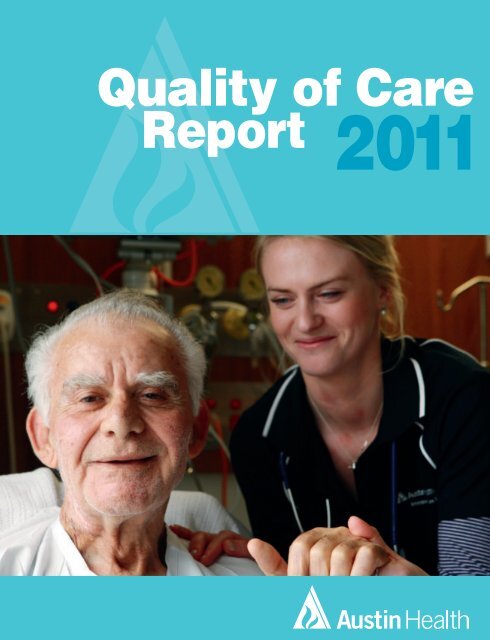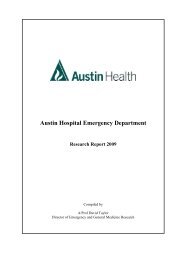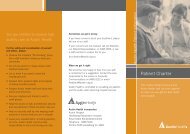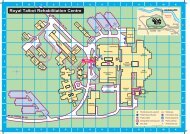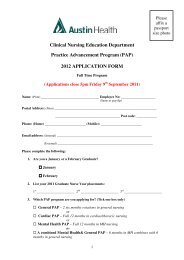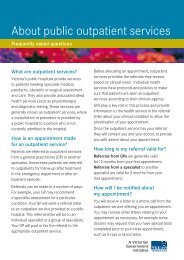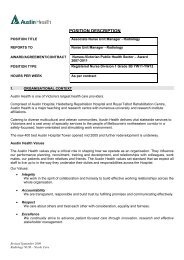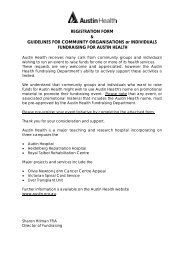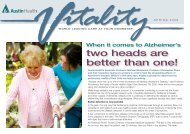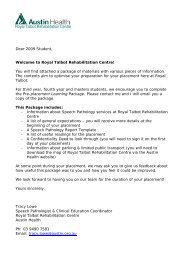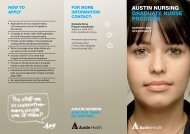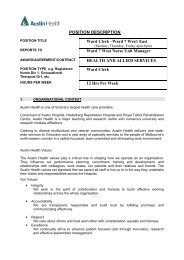Quality of Care Report 2011 - Austin Health
Quality of Care Report 2011 - Austin Health
Quality of Care Report 2011 - Austin Health
Create successful ePaper yourself
Turn your PDF publications into a flip-book with our unique Google optimized e-Paper software.
<strong>Quality</strong> <strong>of</strong> <strong>Care</strong><strong>Report</strong><strong>2011</strong>
ContentsInterpreters ......................................... 2Welcome to <strong>Austin</strong> <strong>Health</strong>’s <strong>2011</strong><strong>Quality</strong> <strong>of</strong> <strong>Care</strong> <strong>Report</strong> ........................ 3Tell us your opinion ............................ 3Keeping you in the loop ...................... 3Our health service in <strong>2011</strong> ................ 4Our vision and values ......................... 4The changing face <strong>of</strong> <strong>Austin</strong> <strong>Health</strong> ..... 5<strong>Quality</strong> and SafetyHow we ensure high quality care ...... 6Accreditation update ......................... 6Journey to Zero ................................. 7Nurses doing the rounds forpatient safety .................................8-9Risk and incident management ...... 10Review <strong>of</strong> patient falls ..................... 10Surgical safety checklist ................. 10Consent processes for bloodtransfusion improved......................... 11Pressure injuries .............................. 12<strong>Quality</strong> a high priority asemergency cases rise ...................... 12Cleaning epidemic .......................... 13One year <strong>of</strong> surgery at<strong>Austin</strong> <strong>Health</strong> ..............................14-15Young consumer voices shapemental health services..................... 16Darley House is a home awayfrom home ....................................... 17Consumer ParticipationRedesign <strong>of</strong> clinical pathwayresults in better care ....................18-19New fracture model <strong>of</strong> care ............ 19Working hand in hand withthe community ................................. 20Veteran legacy ................................. 22A family’s courage .......................... 22Aboriginal and Torres Strait Islander<strong>Health</strong> Program ................................ 23Sorry Day ........................................ 23Cultural Responsiveness Plan ........... 24Working in partnership strengthenscultural understanding ..................... 25How to become involved atthe <strong>Austin</strong> ......................................... 25Encouraging feedback improvesquality <strong>of</strong> service .............................. 26Patient complaint adds to change<strong>of</strong> practice ........................................ 26Nursing health assistants boostpatient satisfaction ......................... 27Charter <strong>of</strong> <strong>Health</strong> <strong>Care</strong> Rightsand Responsibilities .......................... 27Continuity <strong>of</strong> <strong>Care</strong>Screening tool helps cancerservices meet patients’ needs......... 28Home based services increaseoptions for dialysis patients ............. 29Look after your kidneys ................... 29New business carves future forrehabilitation patients ...................... 30The Talbot Tornados ........................ 30Brain Disorders Program supportsthe journey to independence .......... 31Research aims forneurological recovery .................32-33Empowering patients ...................... 34Green Therapy .................................. 35Accessing <strong>Austin</strong> <strong>Health</strong> .................. 36Contact directory .............................. 36IV innovation increasesmedication safety............................. 11Transplant recipient volunteers timeto help others ................................... 21We provide interpreters and an Aboriginal HospitalLiaison Officer as part <strong>of</strong> our care and respect for patients.MACEDONIANARABICITALIANSERBIANZeina BeiroutyThea LonghiZlatko BlajerMANDARINCANTONESETURKISHSizin dilinizi konusuyorumHelen KyriacouStavroulaAntonpoulosConstance ChikAlev TanyerGREEKSuzanne NelsonABORIGINALHOSPITALLIAISON OFFICERFOR MORE INFORMATIONContact Cultural Diversity UnitKaterina StefanovPh 03 9496 3367katerina.stefanov@austin.org.au2 <strong>Austin</strong> <strong>Health</strong>
QUALITY AND SAFETYJourney to ZeroStaff expertise and commitment to patient-centred care has enabled anumber <strong>of</strong> projects tackling adverse events to be successfully introduced.<strong>Austin</strong> <strong>Health</strong> has looked to the US navy,Australian Commission on Safety and<strong>Quality</strong> in <strong>Health</strong> <strong>Care</strong> guidelines and local‘safety heroes’ as part <strong>of</strong> its patient safetyinitiatives to reduce adverse events.Medical staffdiscuss a patient’sobservation chart.Building on <strong>Austin</strong> <strong>Health</strong> CEO Dr BrendanMurphy’s commitment that 2010 wouldbe the Year <strong>of</strong> Safety at the health servicea number <strong>of</strong> initiatives to increase patientsafety were commenced. Journey to Zero,an umbrella term for projects developedwith the aim <strong>of</strong> reducing adverse events tozero by working on areas for improvementidentified by staff, was implemented.The ISBAR project introduced astandardised framework for the reliableand consistent exchange <strong>of</strong> information,utilising a mnemonic ISBAR, with theletters standing for: Identify, Situation,Background, Assessment and Request,adapted from the US Navy’s system forcritical communication, SBAR.ISBAR was a response to the informationderived from the Patient Safety CultureSurvey and reviews <strong>of</strong> adverse events thathighlighted effective staff communicationabout patients’ condition and needs athandover is essential. In February <strong>2011</strong>,a pilot <strong>of</strong> the ISBAR framework in theEmergency Department and ward 8 westshowed it was effective in improvingcommunication, with over 80% <strong>of</strong> staff usingthe format after they completed training.ISBAR was then implemented across<strong>Austin</strong> <strong>Health</strong>, with more than 2,800 clinicalstaff trained in its use and the creationand display <strong>of</strong> posters on the project.An evaluation <strong>of</strong> the initiative is plannedfor later this year.Another Journey to Zero project is theredesign <strong>of</strong> observation and responsecharts which was undertaken to aid nursingstaff to identify early when a patient may bedeteriorating and make it clear when theyshould call for assistance. The new chartswere based on work from the AustralianCommission on Safety and <strong>Quality</strong> in <strong>Health</strong><strong>Care</strong>. A trial on ward 6 West last year founduse <strong>of</strong> the charts increased the number <strong>of</strong>times staff called for assistance, based onearly changes in their patients’ observations,from around ten to 83%.<strong>Austin</strong> <strong>Health</strong> is currently trialling the chart ona further four wards with plans to implementthroughout the health service in 2012.Nine patient safety posters have also beendeveloped, highlighting the importance <strong>of</strong>safety every day and providing tips for staff.The posters were developed to be relevantto each <strong>Austin</strong> <strong>Health</strong> site and feature localclinical leaders. Project coordinator, KatieYeaman says, ‘We thought the messagewould be more powerful if delivered bya staff member who was well respected andknown to be a safety champion’.The posters are being circulated throughoutstaff areas and via the <strong>Austin</strong> Hub for theremainder <strong>of</strong> <strong>2011</strong>.Patient safety posters, providing tips for staff, aredisplayed across staff areas <strong>of</strong> the hospital.<strong>Quality</strong> <strong>of</strong> <strong>Care</strong> <strong>Report</strong> 7
QUALITY AND SAFETYNURSES DOINGTHE ROUNDSFOR PATIENTSAFETYA new model <strong>of</strong> care for nurses draws onthe experience <strong>of</strong> other hospitals to improvepatients’ outcomes and comfort.Nurses Adele Colosimo and Eleanor Rovers check onpatient Margaret Trufitt as part <strong>of</strong> Nurse Rounding.Noting the partner <strong>of</strong> a very sick patientis showing signs <strong>of</strong> distress, Nurse UnitManager Rebecca Monger makes a mentalnote to request a psychological referral.She adjusts the face mask <strong>of</strong> another patientand thanks the daughter <strong>of</strong> an elderlyman who alerts her to the fact he has anadvanced care plan, which restricts the use<strong>of</strong> extreme medical interventions.These interactions are encouraged as aresult <strong>of</strong> the introduction <strong>of</strong> Nurse Rounding.This project commits nurses to check ontheir patients every hour, and fill out a listconfirming they have ensured any toileting,pain, and comfort needs have been met.As Nurse Unit Manager, Ms Monger does atleast one round a day to show leadership toher staff. She says the proactive approachto nursing is refreshing, and the results havebeen impressive with patients’ usage <strong>of</strong> thebuzzer to call for assistance falling by 44%.‘That says to me they don’t need to buzz,’Ms Monger says. ‘There’s a calmer vibe,you can feel it’s more controlled, there’snot the noise pollution <strong>of</strong> the buzzer, it’squiet and controlled, and everyone loves it.’There are 32 patients on the Orthopaedicand Plastics Ward, and whilst the tennursing staff on a day shift are constantlyattending to the clinical needs <strong>of</strong> theirpatients, without a formal requirementto check them hourly, concerns could bemissed. ‘Particularly the older patientsdon’t want to bother the nurses,’Ms Monger says.‘Nurses are very good at being busy,’ MsMonger says. ‘If you see the nurse sitting bythe bed having a chat or a laugh, there’s aperception they should be doing something.This is about giving them permission to stopand just ask their patients “are you OK?”’Nurse Rounding Project Officer KathrynSalamone says <strong>Austin</strong> <strong>Health</strong> piloted NurseRounding after noting the experience <strong>of</strong>other health services here and overseaswhere it had been introduced.8 <strong>Austin</strong> <strong>Health</strong>
QUALITY AND SAFETYNurse Unit Manager RebeccaMonger chats with patientAnna Mastropado during theNursing Round she completeseach day to show leadershipfor patient safety.‘It’s about patient safety, reducing falls,keeping patients informed, reducingpressure injuries and making sure theirneeds are met and they know thatsomeone is coming back to check on themand make sure they have everything theyneed in reach - glasses, book, hearing aid,tissues’ Ms Salamone says.After a successful pilot on two acutewards, including Ms Monger’s Orthopaedicand Plastics Ward, Nurse Rounding is nowbeing rolled out across <strong>Austin</strong> <strong>Health</strong>.‘The patients are happier, more settled, it’squiet, staff are happier,’ Ms Salamone says.‘It’s a patient-centred culture change.’Number <strong>of</strong> calls120010008006004002000Patient calls for assistance on Orthopaedic and Plastic WardsWeek 1 Week 3 Week 5 Week 7 Week 9 Week 11 Week 13Project weeksGraph highlighting the impact <strong>of</strong> Nurse Rounding which has resulted in a 44% decrease in the number <strong>of</strong>patient calls for assistance over a 13 week period.<strong>Quality</strong> <strong>of</strong> <strong>Care</strong> <strong>Report</strong> 9
QUALITY AND SAFETYRisk and incidentmanagement<strong>Austin</strong> <strong>Health</strong> measures and fixes problemsbefore they happen.<strong>Austin</strong> <strong>Health</strong> has introduced an updated incident monitoring tool as part <strong>of</strong> its commitmentto reducing harm to patients.An electronic risk management tool, the Victorian <strong>Health</strong> Incident Management System(VHIMS), was introduced at <strong>Austin</strong> <strong>Health</strong> in October last year. The system is to be used byall Victorian public health services to ensure a standardised approach to incident reporting.VHIMS is used by staff to report incidents, clinical issues, hazards, safety risks and nearmisses, and is available on every computer desktop across the health service. It is used tomonitor the number and type <strong>of</strong> incidents to identify where there are common events, suchas falls, medication errors and pressure injuries, so any trends can be identified and tackled.Serious incidents are automatically escalated, ensuring there is a rapid response and aninvestigation, which can lead to practice change to prevent a recurrence.In 2010, <strong>Austin</strong> <strong>Health</strong> had a 15% increase in the number <strong>of</strong> clinical incidents reportedfrom the previous year. This increase does not mean that more things are going wrong,but instead indicates that the patient safety culture across the organisation has improved.Staff are becoming more confident and familiar with the reporting system, there is increasedaccountability in reporting incidents, and because <strong>of</strong> the ‘no blame’ approach to incidentreview, staff are feeling more confident that system measures will be put in place inresponse to an incident.<strong>Austin</strong> <strong>Health</strong> also introduced a Clinical Review Panel in 2010. On a monthly basis,a panel <strong>of</strong> senior staff – including representatives from medical (surgeons, physicians,and anaesthetists), nursing, allied-health, radiology and pharmacy – meet to discussthe investigation outcome <strong>of</strong> serious adverse events and develop practical, tangiblerecommendations for improved patient care. Since its introduction in October, the panelhas reviewed over 11 cases, conducted a major review <strong>of</strong> falls and is overseeing theimplementation <strong>of</strong> over 36 recommendations to improve patient care.Number <strong>of</strong> reported clinical incidents100009000800070006000500040003000200010000Number <strong>of</strong> reported clinical incidents by year2007 2008 2009 2010YearGraph showing a 15% increase in the number <strong>of</strong> incidents reported by staff in 2010 which reflects animprovement in the patient safety culture across <strong>Austin</strong> <strong>Health</strong>.REVIEW OFPATIENT FALLSIn January, the Clinical Review Panelreviewed 6,125 falls incidents reportedby staff from July 2007 to October 2010.The review showed that despite utilisingbest-practice risk-assessment tools andpreventative strategies, <strong>Austin</strong> <strong>Health</strong>’sfalls incidence, particularly those fallsthat result in patient harm, had remainedstatic over the past three years.The review uncovered key informationabout the factors contributing to falls,such as that 70% occurred in thebathroom and 50% were related togoing to the toilet. This knowledgesupported the implementation <strong>of</strong>Nurse Rounding, a new patient safetyinitiative which has reduced falls whenintroduced at other healthcare services.SURGICALSAFETYCHECKLIST<strong>Austin</strong> <strong>Health</strong>’s clinicians workto eliminate risks to patients byimplementing world’s best practicesuch as the World <strong>Health</strong> Organisation’s(WHO’s) Surgical Safety Checklist.The checklist ensures the operatingteam <strong>of</strong> surgeons, anaesthetists andnurses conduct key safety checks priorto certain stages <strong>of</strong> surgery.Associate Pr<strong>of</strong>essor Larry McNicol,who was instrumental in theimplementation <strong>of</strong> the checklist across<strong>Austin</strong>, says ‘in 2003, the <strong>Austin</strong>Hospital was arguably the first hospitalin Australia to perform “time out” asa final check before surgery. Whencombined with the <strong>Austin</strong>’s OperatingRoom Passport (a checklist performedbefore a patient is transferred to theanaesthesia room), the WHO checklistis helping us to ensure we are doingthe right operation, on the right patientin the most appropriate way’.10 <strong>Austin</strong> <strong>Health</strong>
QUALITY AND SAFETYIV innovation increasesmedication safetyNew technology prevents the accidentaladministration <strong>of</strong> potentially harmful levels <strong>of</strong>intravenous medication.At least six potentially fatal errors havebeen averted and 421 adverse drug eventsavoided through the use <strong>of</strong> new ‘smart’intravenous (IV) pumps across <strong>Austin</strong> <strong>Health</strong>.IV pumps are used to regulate the ratethat fluids and medications are infuseddirectly into a patient’s bloodstream and anenormous 1,700 IV infusions are set up dailyat <strong>Austin</strong> <strong>Health</strong>.Recently <strong>Austin</strong> <strong>Health</strong> invested in 520Alaris ‘smart’ pumps to increase medicationsafety. Deputy Director <strong>of</strong> Nursing andAmbulatory Services, Shane Crowe says,‘Traditional pumps only regulate the flow,how fast it comes through. The smart pumpregulates how much <strong>of</strong> a medication canbe administered.’The smart pumps require staff members toinput which medication they are infusingand how much <strong>of</strong> it they want to add to theintravenous solution. ‘The pump is pre-setwith some predetermined limits around whatis safe and therapeutic. It has a hard limit,a s<strong>of</strong>t limit and a therapeutic dose range.’If staff input a dosage within the therapeuticdose range, it is administered, but if thedose breaches the s<strong>of</strong>t limit, they are givena prompt to check if that was their intention.If it was, then they can press ‘yes’ and thedose will be administered, if it was an error,it gives the staff member an opportunity torevise the dose.However, if a staff member accidentallyinputs a dose level that breaches the ‘hardlimit’, set at a level deemed to be medicallyunsafe, the pump does not allow it.One error that a smart pump averted waswhen a staff member programmed a 1000ug/kg/min dose <strong>of</strong> noradrenaline, instead <strong>of</strong>100 ug/kg/min. ‘The difference <strong>of</strong> one zero issignificant, and the pump saved that patientfrom an overdose,’ Mr Crowe says.The ‘smart’ IV pumpreduces the chance <strong>of</strong>dosing errors.The pumps are providing an average <strong>of</strong> 60alerts a day, with nearly four <strong>of</strong> those alertsresulting in the dose being reprogrammed,meaning an error has been averted.The pump also uses tall letters whendisplaying the name <strong>of</strong> the medication, suchas DoPaMine, to make it easier for staffto differentiate between drugs with similarsounding names, like DoBuTaMine.‘No staff member ever plans to makean error, this is just one more check, atechnological check, that has made a realdifference,’ Mr Crowe says.Mr Crowe says <strong>Austin</strong> <strong>Health</strong> was one<strong>of</strong> the first health services in Australiato introduce the new technology. ‘Otherhospitals have asked for our dataset tolearn from our experience.’CONSENTPROCESSESFOR BLOODTRANSFUSIONIMPROVEDA new consent form has beendeveloped by <strong>Austin</strong> <strong>Health</strong> to increasepatients’ awareness <strong>of</strong> the risks andbenefits <strong>of</strong> blood transfusions and torespect their choices. The form is usedacross all surgical and medical servicesin conjunction with an informationbooklet on blood transfusion.The introduction <strong>of</strong> the new form was arecommendation by both the AustralianCouncil on <strong>Health</strong>care Standards andAustralian and New Zealand Society<strong>of</strong> Blood Transfusion to improvecommunication between clinicians andpatients about blood transfusions.The new form was launched in May<strong>2011</strong> and compliance has passedexpectations, exceeding 98%.Dedicated and enthusiastic nursingand medical champions ensured thetwo month implementation programwas successful by promoting thenew form, informing staff about theirresponsibilities, and reviewing currentpatient flow through the health serviceto determine the best timing forobtaining consent.The safety <strong>of</strong> blood and blood productsat <strong>Austin</strong> <strong>Health</strong> is overseen by theBlood Transfusion Committee which hasrepresentation from surgery, medicine,nursing, the executive team and clinicaleducation. The key roles <strong>of</strong> the BloodTransfusion Committee include:• management and oversight <strong>of</strong> activitiesrelated to transfusion <strong>of</strong> blood andblood products at <strong>Austin</strong> <strong>Health</strong>• implementations <strong>of</strong> changes in line withbest practice, taking into considerationscientific evidence, ethical and medicolegal aspects• reviewing the performance <strong>of</strong> the <strong>Austin</strong><strong>Health</strong> transfusion service<strong>Quality</strong> <strong>of</strong> <strong>Care</strong> <strong>Report</strong> 11
QUALITY AND SAFETYPRESSUREINJURIESA commitment to continuously improvingthe incidence <strong>of</strong> pressure injuries hasenabled <strong>Austin</strong> <strong>Health</strong> to reduce its ratesto below the state-wide average forhealth services.Pressure injuries are wounds that areformed as a result <strong>of</strong> prolonged pressureto an area <strong>of</strong> skin. Pressure injuries arerecognised worldwide as a commoncause <strong>of</strong> harm to patients and maycause significant pain for patients andslow recovery.Every year <strong>Austin</strong> <strong>Health</strong> undertakesa Pressure Injury Point Prevalencesurvey, an audit <strong>of</strong> pressure injuries ata particular point in time. Each injuryis graded according to a classificationscale, from redness to severe lesions. InDecember last year, 550 inpatients wereassessed. Of those, 14.9% were foundto have a pressure injury, which wasa reduction on the 2003 rate <strong>of</strong> 34%,and is considerably lower than the lastreported state-wide average <strong>of</strong> 17.6%.The audit also found the use <strong>of</strong> pressurereducing devices had increased by 2.9%over the previous year.Pressure injury prevention remains ahigh priority at <strong>Austin</strong> <strong>Health</strong> with anexecutive-led injury risk committeeleading the organisation. All patientsare screened on admission andregularly through their stay and staff usestrategies such as special mattressesand pressure-relieving devices forpatients who are considered to be athigh risk <strong>of</strong> developing a pressure injury.% <strong>of</strong> patients with a pressure injuryPressure injury prevalence survey results40353025201510502003 2004 2006 2008 2009 2010Audit yearsGraph tracking the percentage <strong>of</strong> patients witha pressure injury which has decreased from34% in 2003 to 14.9% in 2010.<strong>Quality</strong> a high priorityas emergency cases riseStreamlining quality care is vital as theEmergency Department is faced with growingpatient numbers.Demand for <strong>Austin</strong> <strong>Health</strong>’s EmergencyDepartment (ED) continues to growwith 69,755 patients presenting to thedepartment in 2010-<strong>2011</strong>, an increase<strong>of</strong> 6% on the previous year.In light <strong>of</strong> the rising demand, the ED iscontinually working towards meeting theFederal Government’s aspirational target<strong>of</strong> treating 90% <strong>of</strong> patients within fourhours. Currently, 65% <strong>of</strong> all patientspresenting to the ED, who do not requireadmission to hospital, are treated anddischarged within the four hour window.The triage system ensures the mosturgent cases are prioritised.One <strong>of</strong> <strong>Austin</strong> <strong>Health</strong>’s initiatives to reduceED overcrowding has been the PlannedPatients Arrivals Project. The project, whichwas developed with the input <strong>of</strong> wardstaff, has increased the number <strong>of</strong> patientsDue to the Planned PatientsArrival Project, Laura Lewis,one <strong>of</strong> <strong>Austin</strong> <strong>Health</strong>’s FlowCoordinators, is now ableto admit patients to thewards more quickly from theEmergency Department.discharged throughout the hospital before9am. This has freed up beds to enablepatients to be admitted to wards from theED more quickly.The project has increased the number <strong>of</strong>patients discharged early in the morningfrom less than 1% to between 6 and 10%.Clearly, this is only done when appropriate,and the feedback from patients hasbeen positive.The Emergency Department <strong>Quality</strong> Teammeasures a range <strong>of</strong> key indicators <strong>of</strong> thequality and outcomes <strong>of</strong> treatment to identifyareas for possible improvement, includingthe patients’ experience <strong>of</strong> attending the ED.It also ensures the management <strong>of</strong> specificclinical conditions, such as myocardialinfarction, pneumonia, appendicitis andcertain fractures, are in line with currentworld best practice.12 <strong>Austin</strong> <strong>Health</strong>
QUALITY AND SAFETYCleaning epidemicA new approach to cleaning curbs VRE infections and is just one <strong>of</strong> themany innovative initiatives <strong>of</strong> the infection control team.The B- Clean Program TeamA radical proposal to implement cleaningprocedures normally applied in areascontaminated with Vancomycin-resistantEnterococcus (VRE) to the entire healthservice has led to a significant reduction inthe rates <strong>of</strong> VRE colonisation and infection.VRE is currently a leading cause <strong>of</strong> hospitalinfections in Australia, one <strong>of</strong> the known‘superbugs’. In February 2010, the healthservice introduced a standardised approachto hospital cleaning using a single bleach/detergent that is effective against all current‘superbugs’, and launched an educationalapproach for cleaners that improvesstandards whilst reducing unnecessary waste.A 12 month post-implementationinvestigation found the B-Clean Programreduced annual VRE bloodstream infectionsfrom 22 to five, reducing the number <strong>of</strong>patients who may otherwise have diedas a result.The number <strong>of</strong> patients colonised by VREalso dropped by 40% - the first time therehas been a reduction in the total burden <strong>of</strong>VRE disease at the hospital. As 10-20%<strong>of</strong> those who acquire VRE colonisationgenerally go on to develop an infection,reducing the number who are colonisedwill invariably reduce the number <strong>of</strong> VREinfections and deaths in the future.Another innovative <strong>Austin</strong> <strong>Health</strong> programaims to reduce the risk <strong>of</strong> an infection froman intravenous (IV) line. IV lines can deliverlife saving treatment but they involve a risk<strong>of</strong> developing an infection in the blood,known as a bacteraemia, which can beserious and sometimes even fatal. While<strong>Austin</strong> <strong>Health</strong> IV infection rates are low, theproject team believes they should be zero.The Infection Control Team, working withclinical staff, audited the insertion andongoing care <strong>of</strong> IV lines in the hospital.These audits identified gaps such as staffnot allowing enough time for the solutionused to clean the skin to work properly.The results <strong>of</strong> the audits were shared withstaff to increase their awareness <strong>of</strong> theneed for consistent and improved practice.To support correct insertion <strong>of</strong> the IV line,a kit is being developed that will providestaff all necessary equipment in one place.Monitoring Infection Control<strong>Austin</strong> <strong>Health</strong>’s infection control programcoordinates a wide range <strong>of</strong> activitiesincluding monitoring and benchmarkinginfection rates, hand hygiene compliance,staff immunisation and environmentalstandards. Results are reported to theInfection Control Committee and seniorquality committees in the organisation.Standards <strong>of</strong> cleaning are monitored bya quarterly external cleaning audit, whichspecifies the Acceptable <strong>Quality</strong> Level forvery high risk areas as 90 and for high andmoderate risk areas 85. <strong>Austin</strong> <strong>Health</strong> hasmet these standards in <strong>2011</strong>, averaging90 across all areas.100806040200Hand hygiene compliance<strong>Austin</strong> <strong>Health</strong>National AverageMar-10 Apr-10 Nov-10 Mar-11Graph comparing <strong>Austin</strong> <strong>Health</strong>’s hand hygienecompliance rates with the National average.<strong>Quality</strong> <strong>of</strong> <strong>Care</strong> <strong>Report</strong> 13
QUALITY AND SAFETYONE YEAR OFSURGERY ATAUSTIN HEALTHIn 2010-<strong>2011</strong> we performed …A total <strong>of</strong> 10,594 surgeries2,327 orthopaedic surgeries655 thoracic surgeries457 cardiac surgeries46 liver transplants2 new technology funded directdiaphragm pacing proceduresAustralia’s first intestinaltransplantKeeping track <strong>of</strong>our quality <strong>of</strong> careTo ensure the surgical services are safe and effective and givethe best service to the community we use a framework <strong>of</strong> clinicalgovernance to monitor and measure data that reflects theperformance <strong>of</strong> our services. The range <strong>of</strong> indicators we monitoris based on the Victorian <strong>Quality</strong> Council ‘dimensions <strong>of</strong> quality’:safety, effectiveness, appropriateness, acceptability, access andefficiency. Using these indicators we strive to achieve a balance,that means we do not increase efficiency at the expense <strong>of</strong> safety,or provide high quality service that is financially unsustainable.By monitoring data across these dimensions, we know what ishappening within our busy departments. The system will flag ifsomething is starting to go <strong>of</strong>f track. We can then investigateand take what ever steps are necessary to manage the situation.Some examples <strong>of</strong> the data that is measured across our surgicalservices under the six dimensions <strong>of</strong> quality include:Safety: Clinical incidents are adverse events or near misses thatimpact on patients while receiving health care. Clinical incidentsare reported and acted on quickly to minimise the risk <strong>of</strong> harmto patients. Across the Surgical program in 2010/<strong>2011</strong> there werea total <strong>of</strong> 626 incidents reported, with the most serious <strong>of</strong> theseall having in-depth investigation and follow-up. In one examplea patient fell <strong>of</strong>f a ‘hovermat’ – a specialist piece <strong>of</strong> equipment usedto transfer patients to the operating table. Although the patient wasnot harmed, the investigation and follow-up <strong>of</strong> this incident led tothe purchase <strong>of</strong> new equipment and specialised training for staffin the use <strong>of</strong> the ‘hovermat’.80Incidents reported in the Surgical Program (2010- <strong>2011</strong>)Number <strong>of</strong> clinical incidents706050403020Jul Aug Sep Oct Nov Dec Jan Feb Mar Apr May Jun2010 <strong>2011</strong><strong>Austin</strong> <strong>Health</strong>’s surgeons performing Australia’s first intestinal transplant.Effectiveness: Fractured neck <strong>of</strong> femur (NOF) is a seriousconsequence <strong>of</strong> falls among older people. In 2010 <strong>Austin</strong> <strong>Health</strong>implemented a dedicated ortho-geriatric service to ensure thatother medical issues patients with NOF may have, were assessedand managed in a streamlined manner. Furthermore, close attentionwas paid to why patients were delayed in getting to theatre. As adirect result <strong>of</strong> these initiatives, there has been a trend <strong>of</strong> reducedtime patients waited before having the operation to repair theirfractured NOF.14 <strong>Austin</strong> <strong>Health</strong>
QUALITY AND SAFETYAverage time to theatre (hours)Average time in hours, patients stayed in hospitalbefore attending operating theatre for fractured neck <strong>of</strong> femur806040200Sep 09 Dec 09 Mar 10 Jun 10 Sep 10 Dec 10Average % within 24 hours 48 hoursPercentage <strong>of</strong> cases% <strong>of</strong> elective surgery cases postponed by the hospital (HIPs)14121086420Jul 09 Nov 09 Mar 10 Jul 10 Nov 10 Mar 10 Jun 11Actual TargetAppropriateness: <strong>Health</strong> services must ensure that services areprovided appropriately based on the urgency <strong>of</strong> the case, while alsoensuring the non urgent patients receive treatment without undue delay.Hospital Initiated Postponements (HIPs) are a measure <strong>of</strong> the number<strong>of</strong> scheduled surgical procedures that are postponed due to factorssuch as emergency cases taking priority or lack <strong>of</strong> availability <strong>of</strong> beds.HIPS routinely increase during winter months when there is a seasonalincrease in emergency demand for hospital beds. <strong>Austin</strong> <strong>Health</strong>monitors the percentage <strong>of</strong> HIPs and aims to stay below theDepartment <strong>of</strong> <strong>Health</strong> target <strong>of</strong> 8.0% while maintaining the priority<strong>of</strong> emergency cases.Acceptability: Monitoring patient satisfaction is key to knowing thequality <strong>of</strong> the service provided and how this is experienced by patients.Patient satisfaction is regularly monitored within the Surgery andEndoscopy Centre (SAEC). In 2010, patient satisfaction rates withinSAEC were high, however problems were identified with physicalfacilities and as a result, changes were made to the environment.Elective surgery waiting list number<strong>of</strong> category 2 and 3 patients waiting longer than maximum1,2001,000% <strong>of</strong> patients satisfi ed100%80%60%40%20%Patient satisfaction rates in the Surgicaland Endoscopy Centre in 2010Number <strong>of</strong> patients8006004002000Jul 09 Nov 09 Mar 10 Jul 10 Nov 10 Mar 10Category 2 Category 3Jun 110%Was adequateinformationprovided prior?Was adequateinformationprovided afterthe procedure?Was theenvironmentfavourable toyour recovery?Did you havea positiveexperienceoverall?Efficiency: <strong>Health</strong> services must ensure that resources are utilised toachieve value for money. <strong>Austin</strong> <strong>Health</strong> surgery patients can return homealmost a day earlier on average in 2010/<strong>2011</strong> than in 2006/2007 due toa range <strong>of</strong> service improvements.Access: The urgency <strong>of</strong> cases waiting for elective surgery is categorisedand waiting lists are managed to ensure that patients have timely andequitable access to the services they need. The Department <strong>of</strong> <strong>Health</strong> inVictoria sets maximum waiting times for each category and the number<strong>of</strong> patients who wait longer than that is monitored. Through streamliningthe management <strong>of</strong> the waiting list, we have achieved a significantreduction in the number <strong>of</strong> patients who wait over the maximum time.Category <strong>of</strong> surgical urgencyMaximum waiting timeAverage length <strong>of</strong> stay6.66.46.265.85.65.4Average length <strong>of</strong> stay for surgery patientsCategory 1Category 2Category 3Emergency cases – no waiting time90 days365 days5.254.82006-07 2007-08 2008-09 2009-10 2010-11Year<strong>Quality</strong> <strong>of</strong> <strong>Care</strong> <strong>Report</strong> 15
QUALITY AND SAFETYYoung consumer voicesshape mental health servicesStreamlined admissions, treatment and increased input in servicedelivery by consumers has led to major improvements in outcomesfor young people with mental illness.A major redesign <strong>of</strong> the model <strong>of</strong> care atthe Child and Adolescent Mental <strong>Health</strong>Service (CAMHS) has cut the serviceswaiting list from 12 months to zero, reducedthe length <strong>of</strong> stay <strong>of</strong> adolescent inpatientsfrom 43 days to 12 and increased theinput <strong>of</strong> consumers in its service delivery.CAMHS provides a range <strong>of</strong> services forchildren, adolescents and their familiesand carers, with inpatient facilities as wellas outpatient and outreach services.Clinical Director Dr Neil Coventry saysCAMHS streamlined its admission andtreatment process in recognition <strong>of</strong> thefact there were people in urgent need <strong>of</strong>help who could not access its services.‘What was happening in our service, likein many other services, was that familieswere coming and having fairly lengthyassessments and having a comprehensivetreatment plan organised and then justdropping out. So it was a not a highlyefficient use <strong>of</strong> time,’ Dr Coventry says.‘So we changed our focus to providea much briefer, focussed assessment,including single session assessments,and we were finding that, for a number<strong>of</strong> families, was sufficient.’The service has begun using sensorymodulation therapies within the twoCAMHS inpatient units, which providechildren and young people with sensoryitems such as s<strong>of</strong>t blankets, largeexercise balls, stress balls, fidget toys,bean bags, hammocks and bubbles tomanage aggression.The sensory modalities are helpingpatients control their emotions, whichhas led to a reduced need for physicalrestraints and seclusion.The gardens at CAMHS provide a tranquil space for patients and staff.‘It means that we are the only adolescentunit in the state that basically never secludesour patients– we have the same sort <strong>of</strong>patients as other services, but we anticipateand have other ways <strong>of</strong> distracting anddiverting that aggressive behaviour,’ DrCoventry says.‘The other thing we’ve developed is a verystrong, consumer and carer focus. So wehave a consumer carer support group andan advisory group <strong>of</strong> young people whohave previously been patients <strong>of</strong> theservice. Both <strong>of</strong> those groups are veryactive in helping us to change policies andprocedures and in giving us feedback aboutimprovements from their perspectives.’‘So the voices <strong>of</strong> the consumers and thecarers are much stronger now in shapingour service. That’s been a significantimprovement too.’Consumer initiatives include weeklysessions on the two inpatient units wherepast patients provide peer support to theyoung people who are in hospital, anda weekly drop in centre, where outpatientsand young people can do craft, have a chat,grab a c<strong>of</strong>fee or do some homework, whilstaccessing support if needed.16 <strong>Austin</strong> <strong>Health</strong>
QUALITY AND SAFETYDarley House is a homeaway from homeStaff at Darley House have created a home-style environment toensure that residents receive the respect and comfort they deserve.Rosie, a King Charles Cavalier Spaniel,sports a ‘Therapy Dog’ badge when shevisits her owner Michael Proctor at the<strong>Austin</strong>’s nursing home, Darley House. The<strong>of</strong>ficial Human Resources badge, whichrecognises Rosie as a member <strong>of</strong> the careteam, is just one example <strong>of</strong> Darley House’scommitment to ensuring it is a home, nota facility.‘Therapy dog’ Rosie, with owners Michaeland Valerie Proctor and nurse Gillian Verrall.Michael’s wife, Valarie Proctor brings Rosieto visit every day and says they enjoy thefamily atmosphere <strong>of</strong> Darley House. ‘I sleepwell at night knowing he’s being looked afterso well.’Nurse Unit Managers <strong>of</strong> Darley HouseEast and West, Michelle Spotswood andGenevieve Jepsen, have recently achievedthree-year accreditation for the home,proving that it meets the required aged carestandards. However, Ms Spotswood saysstaff strive to achieve more than the minimum.Residents in the 60-bed home requirecomplex aged care and staff are committedto ensuring they are treated with respect.One initiative has been to have a journalistcompile residents biographies, with 20completed over the past two years.‘It’s a bit <strong>of</strong> a story <strong>of</strong> the residents’ lives,which the staff can share if the familieswish, so they can get a bit <strong>of</strong> an idea aboutwho this person was through their life.’Ms Jepsen says it’s been a wonderfulexperience. ‘It gives the residents a feelingthat their life is being respected, beingvalidated, being heard. You’re actually anactive member <strong>of</strong> the community - andit’s interesting. Probably a lot <strong>of</strong> the familydon’t even know half <strong>of</strong> the informationthat’s been coming out.’Another area targeted for improvement atDarley House is falls. The monthly falls ratesdropped from 17 falls in February 2009 t<strong>of</strong>ive in February this year. This has beenachieved through the use <strong>of</strong> low beds, andbed and chair alarms that alert staff whena resident who is unsteady is standing.The home has introduced a protocol that ifa resident has a second fall, a staff memberfrom the other wing will come over to reviewthe falls checklist to see if there are any otherstrategies that could be put in place. TheNumber <strong>of</strong> falls120100806040200Jan-Jun2008Jul-Dec2008Jan-Jun2009falls data is also reviewed at staff meetings,to keep staff informed <strong>of</strong> how they are doing.Housekeeping staff are now involved in fallsprevention. ‘If they see someone start tostand up, they’ll be there and be proactiveand make sure that person has support orthat they are assisted back to a chair or theywill contact one <strong>of</strong> the staff. Everybody’sinvolved in falls management. I think that’svery important,’ Ms Spotswood says.Number <strong>of</strong> resident fallsJul-Dec2009Half year intervalJan-Jun2010Jul-Dec2010Jul-Dec<strong>2011</strong>Graph showing that since the introduction <strong>of</strong> specialised prevention equipment in 2010, resident falls atDarley House have halved.<strong>Quality</strong> <strong>of</strong> <strong>Care</strong> <strong>Report</strong> 17
CONSUMER PARTICIPATIONREDESIGNOF CLINICALPATHWAYRESULTS INBETTER CAREAn initiative to improve the hospital journey<strong>of</strong> patients who have fractured their neck<strong>of</strong> femur, or thigh bone, is reaping rewards.Melodie Heland, Director <strong>of</strong> the Surgical ClinicalService Unit, interviews a patient to understand whatcould be done to improve his experience.An initiative to improve the hospital journey<strong>of</strong> patients who have fractured their neck<strong>of</strong> femur, or thigh bone, is reaping rewards.Patients presenting to <strong>Austin</strong> <strong>Health</strong> witha fractured neck <strong>of</strong> femur (NOF) arereceiving pain relief earlier and their patientjourney has been streamlined thanks toa project that has come right from the top.CEO Dr Brendan Murphy was just one<strong>of</strong> <strong>Austin</strong> <strong>Health</strong>’s executive team whointerviewed patients with a fractured neck<strong>of</strong> femur to determine what could be doneto improve their patient journey. As aresult <strong>of</strong> patient feedback, four areas weretargeted for redesign: pain, time to surgeryand fasting, pressure injuries and delirium.Project Lead Fiona Nielsen says, ‘Westarted <strong>of</strong>f with a walk-through <strong>of</strong> all thekey points the patient would actually travelthrough. It was the first time we’d donethat, where we actually followed the patientjourney from the front door in ED rightthrough the back door when theyget discharged.’Ms Nielsen says the involvement <strong>of</strong> hospitalexecutives and Orthopaedic SurgeryDirector, Mr Andrew Hardidge, was pivotalto the success <strong>of</strong> the project. ‘I think itshowed there was a strong commitment tomake this project work and everybody wasbehind it.’In 2010, 167 patients presented to <strong>Austin</strong><strong>Health</strong> with a fractured neck <strong>of</strong> femur,an extremely painful condition. However,data from the Emergency Departmentshowed only 33% <strong>of</strong> patients were receivingpain blocks in their hip area rather thanopiates, which are less reliable andnot as long lasting.The use <strong>of</strong> pain blocks in the EmergencyDepartment has now increased to nearly90% and the new pain plan extends to thewards where patients are immediately givenanalgesia. The Acute Pain Service receives18 <strong>Austin</strong> <strong>Health</strong>
CONSUMER PARTICIPATIONPatient status at a glanceboard assists staff in planningand coordinating care.a referral for every NOF patient to helpthem mobilise and on their way to recoveryas quickly as possible.Fasting for at least six hours is arequirement prior to surgery, but there wereissues with patients being inadvertentlyfasted for much longer. Sourcing food whena patient’s fast ended outside a meal timewas also a problem.A big success has been the introduction <strong>of</strong>the ‘hunger clock’ at the patient’s bedside.‘The clock goes up with the starting fastingtime and every hour the nurse moves thehands. This provides a visual trigger fornurses to regularly check on the patient’stheatre waiting time’.The Orthopaedic Interdisciplinary Team arecommitted to ensure that patients and theirfamilies receive person-centred, evidencedbasedcare that is co-ordinated, integratedand consistent. This philosophy <strong>of</strong> care issupported by a revised clinical pathwaywhich documents the critical elements <strong>of</strong>the patient journey.NEW FRACTURE MODEL OF CAREA new model <strong>of</strong> care for older patients with fractures is reducing the amount <strong>of</strong> timethey need to spend in hospital and has been welcomed by staff and surgeons alike.Clinical Associate Pr<strong>of</strong>essor and Senior Geriatrician Dr Mike Dorevitch says many olderpatients who present to hospital with a fracture have other health issues. These comorbidconditions <strong>of</strong>ten signal underlying ill health and can contribute to injurious falls.‘If you just focus on fixing the fracture those co-morbidities can be overlooked and theopportunity to improve their health status can be missed,’ A/Pr<strong>of</strong>. Dorevitch says.The new service is a collaboration between the Orthopaedic Unit and the Aged <strong>Care</strong>Service and has created a new, full-time position <strong>of</strong> a Geriatric Medical Registrar inthe Orthopaedic Unit.‘We are well placed to see these patients as soon as they present to hospital andto follow them pre- and post-operatively until they are discharged. Working withina multi-disciplinary team framework, we are better able to manage common agerelatedissues such as falls, polypharmacy and underlying metabolic bone disease,as well as post-operative pain and other complications such as delirium and anaemia,’A/Pr<strong>of</strong>. Dorevitch says.Since the model <strong>of</strong> care was introduced in February last year, the acute hospitallength <strong>of</strong> stay <strong>of</strong> the target patient group has dropped from 14.6 to 8.3 days.<strong>Quality</strong> <strong>of</strong> <strong>Care</strong> <strong>Report</strong> 19
CONSUMER PARTICIPATIONWorking hand in handwith the communityAt <strong>Austin</strong> <strong>Health</strong> we work with consumers to create better, more responsive services using theDepartment <strong>of</strong> <strong>Health</strong>’s Consumer Participation Standards (outlined in the Doing it with us not forus. Strategic direction 2010–13). The table below details our progress.Standard 1 - METOrganisational commitment to consumer participation<strong>Austin</strong> <strong>Health</strong> is committed to consumer, carer and communityparticipation. This includes implementing actions set out in our:• Consumer and Community Participation Policy and Plan• Disability Action Plan• Cultural Responsiveness Plan, and• Improving <strong>Care</strong> for Aboriginal and Torres Strait IslanderPatients program.We use a range <strong>of</strong> approaches to report consumer participationto the wider community and implement processes to supportconsumer consultation and involvement. We are also buildingstaff capacity by developing education resources. One <strong>of</strong>the initiatives undertaken this year is the development <strong>of</strong> theCommunity Advisory Committee Recognition and RewardsProgram. This program aims to highlight the importance <strong>of</strong>consumer participation among staff, as well as building theConsumer Participation Record <strong>of</strong> Influence, a useful resource<strong>of</strong> good practice models.Standard 2 - METConsumer involvement in decision making about their careConsumer and carer satisfaction with their involvement indecision making about their care, treatment and wellbeing isassessed by the Consumer Participation Indicator (CPI) withinthe Victorian Patient Satisfaction Monitor (VPSM). <strong>Austin</strong>scored 75.9% in the latest VPSM in December 2010.The VPSM excludes mental health, so in that area this importantaspect <strong>of</strong> care is assessed on patients’ involvement in thedevelopment <strong>of</strong> their individual care plans.Standard 3 - METProvision <strong>of</strong> information to support consumer decisionsResponding to the VPSM, 90% <strong>of</strong> patients rated <strong>Austin</strong> <strong>Health</strong>’s‘take home’ information as good or excellent. While this result ispleasing, we are continuing to work at improvement. All staff canaccess information on developing appropriate resources via theDepartment <strong>of</strong> <strong>Health</strong>’s Checklist for Assessing Written Consumer<strong>Health</strong> Information. We are developing a new electronic documentsystem with a strengthened model to engage patients andconsumers in creating information.Standard 4 - METConsumers participating in the planning andevaluation <strong>of</strong> services<strong>Austin</strong> <strong>Health</strong> engages consumers in a range <strong>of</strong> ways to ensurethat services meet their needs. This includes participation instrategic planning processes, service, program and communitydevelopment and quality improvement activities.In 2010, consumer feedback contributed to the development<strong>of</strong> the future model for endoscopy services and renal dialysis.Consumers are also represented on a number <strong>of</strong> key committeesincluding ethics, quality and clinical governance committees.This year, the membership <strong>of</strong> the Board Clinical Safety and<strong>Quality</strong> Committee will be strengthened by participation <strong>of</strong> twoconsumers. Consumers participate in monitoring feedback andreviews <strong>of</strong> complaints.In the Mental <strong>Health</strong> area, dedicated consumer and carerconsultants ensure that consumers are active participants inthe planning and evaluation <strong>of</strong> services.Standard 5 - METBuilding the capacity <strong>of</strong> consumers and communitymembers to participateThe 2009 – 12 Community Participation Plan guidesengagement activities in the three key areas <strong>of</strong> consumerparticipation, capacity building and community engagement.This year some activities were:• strengthening the distribution <strong>of</strong> the Charter <strong>of</strong> <strong>Health</strong> <strong>Care</strong>Rights and Responsibilities• consumers participating and presenting at safety andquality conferences, sharing their experiences and learningswith others• seeking community feedback in the development <strong>of</strong> the<strong>Quality</strong> <strong>of</strong> <strong>Care</strong> <strong>Report</strong>• engaging consumers in the development and delivery <strong>of</strong>community education sessions for the Respecting PatientChoices program• development <strong>of</strong> a register that captures the involvement<strong>of</strong> consumer consultants in the Mental <strong>Health</strong> staff’sin-house trainingIf you would like more information about our Community Participation Plan, or to be involved in quality improvement initiatives across<strong>Austin</strong> <strong>Health</strong>, please contact the Consumer Participation Support Officer on 9496 5186.20 <strong>Austin</strong> <strong>Health</strong>
CONSUMER PARTICIPATIONMichael Knight, former liver transplant patient,is now a volunteer guide.Transplant recipientvolunteers time to help othersEvery Thursday morning, Michael Knightgrabs a good book and his iPod inpreparation for the six-hour round trip tothe <strong>Austin</strong> from his home in Pakenham. It’sa huge effort for the former liver transplantpatient who gives his time to volunteer forthe hospital he credits with saving his life.‘I was sent to the <strong>Austin</strong> in 2005 withchronic liver disease and I had a transplantin 2006. So, that saved my life basically andthis is my way <strong>of</strong> giving something back,’Mr Knight says.Mr Knight was one <strong>of</strong> the first intakes <strong>of</strong>volunteer guides, who now number 16.They greet patients at the hospital receptionor in Specialist Clinics (Outpatients) toanswer any queries or dispense some muchneeded reassurance.‘Because it’s such a big place, peopleare getting lost, they walk in and theyhaven’t got a clue where they’re going andsometimes they’re quite frustrated andscared…so we just try to make their journeya little bit easier,’ Mr Knight says.‘If people need taking somewhere, or arelost, you help them out. Also if someonelooks a bit distressed while they’re sittingand waiting for their appointment, I mightmake them a cuppa.’Mr Knight says the feedback from patientshas been overwhelmingly positive.‘I actually had one lady give me a kiss oneday because she was so frightened whenshe arrived, and she had no idea how toget to respiratory lab and when I got herdown there, she just gave me a peck onthe cheek and said, “You people are doingsuch a great job”.’‘I had one lady get into the lift one day andshe looked in a bad way so I said to her,“You alright?”, and she said, “Yeah, I’m justtaking my husband’s washing home, he’sgoing through a liver transplant.” I said,“Believe me, he looks rough now, but don’tworry, I’ve had one myself,” and she justburst out in tears … She was really happyto see how I’d progressed. That gave herhope. Now her husband’s had his livertransplant and they make a point <strong>of</strong> comingto see me when they’re there.’‘It’s good therapy for me, emotionally andphysically. I feel like I’m giving somethingback, not just to the <strong>Austin</strong> but to societyin general.’People interested in volunteering as aguide, or for any other role, can contactVolunteer Services on 9496 2337 or emailvolunteers@austin.org.au<strong>Quality</strong> <strong>of</strong> <strong>Care</strong> <strong>Report</strong> 21
CONSUMER PARTICIPATIONReplica Victoria Cross at theKokoda Gym entrance.Veteran legacySeventy years ago, when the Heidelberg Repatriation Hospital (the Repat) was built duringthe Second World War, one in seven Australians were in the armed services.The Repat has recognised that sobering legacy with a stunning display <strong>of</strong> memorabiliaheld at the Shrine <strong>of</strong> Remembrance in Melbourne over five months earlier this year, and byits ongoing tradition <strong>of</strong> naming buildings, gardens and other locations in the hospital withheritage names linked to the Australian Defence Forces.Veteran Liaison Officer Robert Winther says the display at the Shrine was three years inthe making, involving staff from the Repat, the Shrine and the War Memorial and its qualitywas testament to the fact many Australian families would have had some sort <strong>of</strong> historicalconnection to the Repat.Mr Winther says the veteran links continue to unfold linking the past with the present. One<strong>of</strong> the rooms <strong>of</strong> the new Kokoda Gym is named after Private Edward Kenna VC, who was apatient for more than a year in the 1940s after being shot in New Guinea. During his inpatientstay, Private Kenna was informed by the Commanding Officer, Colonel Thomas, that he hadbeen awarded the Victoria Cross for his bravery. Colonel Thomas’s granddaughter, CathyNall, worked for Repat for many years as the Director <strong>of</strong> Physiotherapy.A large replica Victoria Cross, made <strong>of</strong> bronze, hangs proudly in the lobby <strong>of</strong> the newbuilding. ‘It’s a legacy for those down the track, and when the afternoon sun passes acrossthe Victoria Cross it is a bit <strong>of</strong> magic,’ Mr Winther says.A FAMILY’SCOURAGEThe courage <strong>of</strong> the family <strong>of</strong> a youngAboriginal woman who was broughtto the <strong>Austin</strong> with fatal injuries hasled the way for other health servicesto promote organ donation within theAboriginal community.The 24-year-old woman arrived atthe <strong>Austin</strong> Hospital in February aftersuffering a serious brain injury. Whendoctors declared her brain dead, the<strong>Austin</strong>’s Aboriginal Hospital LiasonOfficer (AHLO), Suzanne Nelson, begantalks with the extended family aboutthe possibility <strong>of</strong> organ donation.Cultural Diversity Manager Kerry Wisesays the organ donation discussionis always hard, but it was made moredifficult as it was a first for the localAboriginal community and because<strong>of</strong> the complex nature <strong>of</strong> Aboriginalfamilies. ‘Their extended families arelarge, supportive and involved and theyhave a lot <strong>of</strong> say in what goes on. It’sa communal decision-making processand everybody needs to be happyabout it,’ Ms Wise says.Ms Nelson coordinated the meetingwhere the family discussed theirchoices with the treating doctorsand organ donation nurse. A multidisciplinaryteam comprising <strong>of</strong>representatives from the Intensive <strong>Care</strong>Unit, social workers, pastoral care,security, the Red Cross, the AboriginalAdvancement League and the Office<strong>of</strong> the Minister for Families, Housing,Community Services and IndigenousAffairs, Jenny Macklin, ensured thefamily’s wishes were followed.‘The whole care team managed a mostdelicate situation with appropriatecultural sensitivity, respect and care,’Ms Wise says.The family’s decision enabled twopatients to receive much neededorgans and since Ms Nelson presentedthe case at a conference in June, otherAHLOs have been inspired to talk tothe families <strong>of</strong> their Aboriginal patientsabout organ donation.22 <strong>Austin</strong> <strong>Health</strong>
CONSUMER PARTICIPATIONAboriginal and Torres StraitIslander <strong>Health</strong> ProgramSuzanne Nelson,Aboriginal HospitalLiaison Officer, chats withpatient David Marnell.The Ngarra Jarra Aboriginal <strong>Health</strong> Programserviced 3,130 patient attendances at<strong>Austin</strong> <strong>Health</strong> in 2010-<strong>2011</strong>, with about half<strong>of</strong> those being outpatients.Aboriginal Hospital Liaison Officers (AHLOs)Suzanne Nelson and Joanne Borg havehad a busy year – they ran 13 trainingsessions for staff in cultural awarenessand the role <strong>of</strong> the AHLOs; they madeappointment reminder phone calls to everyoutpatient who had identified themselvesas Aboriginal or Torres Strait Islander; theyvisited those who failed to attend to identifyand overcome barriers; and they liaisedwith social work, pastoral care, palliativecare and other areas to provide appropriatereferrals and discharge plans.A strong collaborative relationship hasbeen established with Access Services forKoories (ASK), a partnership organisationbetween the Victorian Aboriginal <strong>Health</strong>Service and the Northern Division <strong>of</strong>General Practice. ASK case coordinates15 shared clients in consultation with the<strong>Austin</strong>’s AHLOs to help these patientswith discharge planning and management<strong>of</strong> their own health outcomes.The program is also working on a schemeto assist in the identification <strong>of</strong> Aboriginaland Torres Strait Islander patients onadmission, after receiving a one-<strong>of</strong>f grantfrom the Victorian Department <strong>of</strong> <strong>Health</strong>,and has now developed its own resourcespamphlet, Caring for Aboriginal Patientsin Hospital, with culturally-appropriateinformation for staff.The Ngarra Jarra Aboriginal <strong>Health</strong> programfollows the Improving <strong>Care</strong> for Aboriginaland Torres Strait Islander Patients Program(ICAP) guidelines and operates with thesupport <strong>of</strong> the <strong>Austin</strong> <strong>Health</strong> Aboriginal<strong>Health</strong> Advisory Committee.SORRY DAYThe elements <strong>of</strong> earth, fire and waterwere used in a moving ceremony atthe <strong>Austin</strong> to commemorate the StolenGeneration on Sorry Day in May.Staff, patients and members <strong>of</strong> thecommunity were invited to touch the redearth <strong>of</strong> country, feel the heat <strong>of</strong> fire andthe cleansing flow <strong>of</strong> water as a tributeto those Aboriginal children taken fromtheir families.<strong>Quality</strong> <strong>of</strong> <strong>Care</strong> <strong>Report</strong> 23
CONSUMER PARTICIPATIONCultural Responsiveness PlanThe Cultural Diversity Unit at <strong>Austin</strong> <strong>Health</strong> provides a range <strong>of</strong> quality services to staff and consumerssupported by the Cultural Responsiveness Plan 2010-13, the Ngarra Jarra Aboriginal <strong>Health</strong> Program forAboriginal and Torres Strait Islander Patients and the Interpreter and Translation service. This year the unithas been working towards meeting the following standards outlined in the Department <strong>of</strong> <strong>Health</strong>’s CulturalResponsiveness Framework.Standard 1 - META whole-<strong>of</strong>-organisation approach to culturalresponsiveness is demonstrated• <strong>Austin</strong> <strong>Health</strong>’s Cultural Responsiveness Plan 2010-13 wasdeveloped and approved by the <strong>Austin</strong> <strong>Health</strong> Board, and wassubmitted to the Department <strong>of</strong> <strong>Health</strong>• the Cultural Diversity Committee is planned to convene in thethird quarter <strong>of</strong> <strong>2011</strong>Standard 2 - METLeadership for cultural responsiveness is demonstratedby the health service• resources for written information in plain English and theCaring for Aboriginal Patients brochure have been developed• through the National Sorry Day commemoration, we areraising awareness <strong>of</strong> the Stolen GenerationStandard 3 - METAccredited interpreters are provided to patients who require oneIn 2010-<strong>2011</strong>:• 11,904 interpreter requests were received• interpreters were supplied for 95% <strong>of</strong> all requests• interpreters for 62 different languages were provided• 89.3% <strong>of</strong> requests were for the top 10 languages, with allbut Vietnamese being covered by in-house interpreters• 100% <strong>of</strong> service complaints were addressed and resolved• 100% <strong>of</strong> translation requests were provided in20 different languages• translated patient information was provided in thefive top languagesStandard 4 - METInclusive practice in care planning is demonstratedThe Cultural Diversity Unit contributed to the development<strong>of</strong> cultural plans across some service departments,including culturally appropriate discharge planning forAboriginal patients.Standard 5 - METCulturally And Linguistically Diverse (CALD) consumersinvolved in service planning and improvement• there is regular reporting to the Consumer AdvisoryCommittee (CAC)• links between the CAC, the Aboriginal <strong>Health</strong> AdvisoryCommittee and, in the future, the Cultural DiversityCommittee are maintained by the CAC consumers• Aboriginal Hospital Liaison Officers contributed to the planning<strong>of</strong> the Victoria-wide Improving <strong>Care</strong> for Aboriginal and TorresStrait Islander Patients Program developmental review,including presentation <strong>of</strong> a case studyStandard 6- METStaff provided with development opportunities• Cultural Awareness Training, including the Working withInterpreters session and the Ngarra Jarra Aboriginal ProgramWhat is my role? sessions, have been provided to staffacross <strong>Austin</strong> <strong>Health</strong>Cantonese6%Vietnamese6%Language requests provided in 2010-<strong>2011</strong>(total number = 11,567)Croatian3%Serbian3%Turkish7%Macedonian9%Other11%Arabic10%Greek20%Italian16%Mandarin10%During 2010- <strong>2011</strong> requests for Greek, Italian, Mandarin and Arabicinterpreters constituted over half <strong>of</strong> all language services provided bythe Cultural Diversity Unit.24 <strong>Austin</strong> <strong>Health</strong>
CONSUMER PARTICIPATIONWorking in partnershipstrengthens cultural understanding<strong>Austin</strong> <strong>Health</strong> is committed to providing culturally appropriatecare to its diverse population.Community Advisory Committee representative Yusuf Sheik Omar’s support for the health service is clear,with his name among those engraved in the commemorative circle.HOW TO BECOMEINVOLVED AT THEAUSTINHave you got something to say? Wouldyou like to become involved in shapingservices and improvement initiatives at<strong>Austin</strong> <strong>Health</strong>?There are a number <strong>of</strong> ways in whichpatients, their family members, carers,advocates, friends and members <strong>of</strong>the community at large can participate.Putting your name down on the <strong>Austin</strong><strong>Health</strong> Consumer Register or becominga member <strong>of</strong> the Community AdvisoryCommittee, are just two examples.If you would like further informationabout consumer participation, pleasecontact the Consumer ParticipationSupport Officer on 9496 5186 or e-mailanna.sieracka@austin.org.au.Recently Palliative <strong>Care</strong> Unit staff andmembers <strong>of</strong> the Somali community had theopportunity to work together to strengthentheir understanding <strong>of</strong> how care can bedelivered to meet the needs <strong>of</strong> patientsfrom diverse cultural backgrounds.When an elder from the Somali communitywas admitted to their ward, he wasvisited by many members <strong>of</strong> his familyand community, who organised a cateredgathering on the ward to pay their lastrespects to him. The nursing staff found itchallenging to create a quiet and peacefulatmosphere for other patients in the ward.The ward invited the Cultural Diversity Unitafterwards to discuss strategies for copingwith a similar situation in the future. Nursingstaff decided they would appoint a visitorspokesperson and provide a waiting areain a sheltered garden space away fromother patients. Most importantly, they wereencouraged to continue having respectfulconversations with patients to betterunderstand their cultural beliefs.Community Advisory Committee (CAC)representative Yusuf Sheik Omar has beenworking with the Somali community totry and encourage them to stagger theirvisits to make them more manageable forstaff, but says, ‘everything makes sensewhen you put it in a cultural perspective.In Somali, if I don’t go and visit, theperson’s relatives may perceive I am nota compassionate person. We need to learnfrom each other and develop a toleranceand acceptance as well.’Mr Omar’s input is just one example <strong>of</strong>the importance <strong>of</strong> having a diverse range<strong>of</strong> views on the CAC. Mr Omar joined thecommittee eight months ago with the aim<strong>of</strong> representing the views and concerns <strong>of</strong>Somali and other recently arrived migrantgroups. ‘Banyule has the second largestSomali community in Melbourne, over 3,000people, so they are very heavy users <strong>of</strong> the<strong>Austin</strong>,’ Mr Omar says.Mr Omar is hoping his contribution on theCAC will assist <strong>Austin</strong> <strong>Health</strong> to developmore cultural awareness and sensitivity, hesays, ‘people need some support and someunderstanding <strong>of</strong> other cultures - to putthemselves in the shoes <strong>of</strong> others.’Whilst Mr Omar has no personal experience<strong>of</strong> care at <strong>Austin</strong> <strong>Health</strong>, he has been manytimes to visit family and friends and hisname is on one <strong>of</strong> the donor bricks at theentry to the hospital. ‘I feel a part <strong>of</strong> theplace,’ he says.<strong>Quality</strong> <strong>of</strong> <strong>Care</strong> <strong>Report</strong> 25
CONSUMER PARTICIPATIONEncouraging feedbackimproves quality <strong>of</strong> serviceLyn Roberton and Noelene Stevens neverknow what is going to prompt someone toseek their help, but they always try to ensurethat whatever the problem, every effort ismade to assist.Most complaints that arise can be resolveddirectly by the staff involved at the locallevel. The ‘on the spot’ response toproblems can be a quick and effective way<strong>of</strong> addressing issues before they escalate.It can bring all the involved parties toconsider the best solution to the situationas it unfolds and it can also reduce distressto all involved.‘We encourage patients and family membersto raise their concerns directly with staffproviding care as a first step. However, ifthat is too difficult they can contact us abouttheir concern, so it can be sorted out asearly as possible’ Mrs Roberton says.In the past 12 months the PatientRepresentative Team have handled morethan 2000 cases – each one being seenas a learning opportunity for serviceimprovement.Complaints have ranged from treesobscuring signage to the hospital, to anxietyabout the quality <strong>of</strong> patient care and waitingtimes in the Emergency Department.The majority <strong>of</strong> complaints in the pastfinancial year were related to treatment and/or communication.Every month, complaints data is trended andreviewed by <strong>Austin</strong> <strong>Health</strong>’s peak Executiveand Board level committees, with substantialcomplaints being individually presentedand discussed to ensure that appropriateimprovements have been put in place.Frequently, complaints provide <strong>Austin</strong> <strong>Health</strong>with opportunity to enhance the way inwhich services are provided.When the Patient Representative Officereceived three complaints about a lack<strong>of</strong> wheelchairs for patients being dropped<strong>of</strong>f at the front <strong>of</strong> the hospital, a meeting <strong>of</strong>key staff was called. The result? Four morewheelchairs were purchased and designatedto be kept at reception to facilitate patients’easy access to the treatment areas.‘We were able to get back to the families andapologise, and say, “this is what’s happeningas a result”,’ Mrs Roberton says.The Patient Representative Office canbe contacted on 9496 3566.PATIENTCOMPLAINTADDS TO CHANGEOF PRACTICE<strong>Austin</strong> <strong>Health</strong> is reviewing patientidentification processes to ensure thatthey fall in line with the new nationalstandards. This will reduce a chance<strong>of</strong> incorrect identification as was thecase with a complaint lodged withthe Patient Representative Office bya patient who had a wrong wristbandattached. The patient was concernedthat they may have been given wrongmedications. In response to thiscomplaint the manager <strong>of</strong> the areaundertook an immediate investigationwhich found that the patient’smedications and treatment had all beengiven correctly. The patient was <strong>of</strong>feredan apology and was given reassurancethat his management had not beenaffected because <strong>of</strong> the error.2500Number <strong>of</strong> cases resolved by thePatient Representative Office2010-<strong>2011</strong> <strong>Austin</strong> <strong>Health</strong> complaints by issueTotal number <strong>of</strong> cases20001500100050002007/08 2008/09 2009/10 2010/11Financial yearOver the past financial year, the Patient Representative Officehandled more than 2000 cases.TreatmentCommunicationAccessRightsAdministrationAtmosphereCostThe majority <strong>of</strong> complaints in the past financial yearrelated to treatment (29%) and communication (26%).26 <strong>Austin</strong> <strong>Health</strong>
CONSUMER PARTICIPATIONNursing health assistantsboost patient satisfactionCHARTER OFHEALTH CARERIGHTS ANDRESPONSIBILITIES<strong>Austin</strong> <strong>Health</strong> reviewed and updatedits Charter <strong>of</strong> <strong>Health</strong> <strong>Care</strong> Rights andResponsibilities in 2010 to align it withthe Australian Charter <strong>of</strong> <strong>Health</strong> <strong>Care</strong>Rights, which was developed by theAustralian Commission on Safety and<strong>Quality</strong> in <strong>Health</strong> <strong>Care</strong>. The updatedcharter was distributed across thethree sites and is now provided to allnew <strong>Austin</strong> <strong>Health</strong> employees as part<strong>of</strong> their starter pack.<strong>Health</strong> Assistant Nursing,Carolyn Pogue with Nurse,Nadine BucktonThe health service’s vision in creating a newnursing role has paid dividends for patientsand staff alike.Patient complaints have almost halved in wards benefiting from <strong>Austin</strong> <strong>Health</strong>’s creation <strong>of</strong>a new <strong>Health</strong> Assistant Nursing (HAN) role.<strong>Austin</strong> <strong>Health</strong> introduced six HANs across three wards in a pilot program in 2009 to assistpatients with activities <strong>of</strong> daily life.‘In the six months prior to the introduction <strong>of</strong> HANs, the three pilot wards received a total<strong>of</strong> 60 complaints, this dropped to just 33 in the six months after’, says Ann Maree Keenan,Director <strong>of</strong> Ambulatory and Nursing Services.HANs are able to undertake non-clinical duties that might otherwise have taken longer, ornot happened at all. The HANs ensure that elements <strong>of</strong> patient care, like shaving a malepatient or applying make-up to a female patient are done even when nurses are extremelybusy with the more technical tasks that directly impact on patients’ clinical outcomes.They also assist the nurses to feed patients, assist with toileting and ensuring that patients’hygiene needs are met.‘<strong>Austin</strong> <strong>Health</strong> is the first Victorian Metropolitan health service to create a nursing assistantrole, effectively reducing the workload and stress on Registered and enrolled nurses. It ishoped this strategy to alleviate nurses’ workload will attract greater nursing talent to the<strong>Austin</strong> and have flow-on benefits far into the future,’ Ann Maree concluded.The <strong>Austin</strong> employed 24 additional HANs in May this year, ensuring every acute ward hastwo HANs, with the exception <strong>of</strong> paediatrics, which does not have the same need.As a patient at <strong>Austin</strong> <strong>Health</strong> youhave the right to:• receive high quality care in a safe,comfortable setting• be treated fairly and with respect,regardless <strong>of</strong> your age, gender, sexualpreference, religion and culture• have clear information about yourservices, treatment options and costs• r eceive treatment that meets yourhealth care needs• have your privacy, dignity andpersonal safety respected• give a compliment or makea complaint, your concerns orcomplaints will be taken seriously• leave the hospital against medicaladvice, in most cases, if you leave,you will be required to sign a formaccepting responsibilityTo help us give you the best possiblecare your responsibilities are to:• tell us about your illness and hospitalvisits, symptoms, medications, allergiesand other health-related matters• tell us about your religious or culturalrequirements• treat everyone that you meet at<strong>Austin</strong> <strong>Health</strong> with care and respect• tell us if you are unable to attendyour appointment so that we mayreschedule itThe full version <strong>of</strong> the <strong>Austin</strong> <strong>Health</strong>Charter can be accessed by typingthe word ‘charter’ into the searchbox at www.austin.org.au.<strong>Quality</strong> <strong>of</strong> <strong>Care</strong> <strong>Report</strong> 27
CONTINUITY OF CAREScreening tool helps cancerservices meet patients’ needsA wellness program supports cancer patients with their physical,psychological, social, information and spiritual needs.Learning you have cancer can be confronting.But, whilst the need for medical assistanceis obvious, people’s differing reactions andcircumstances mean they can have a range<strong>of</strong> other needs. <strong>Austin</strong> <strong>Health</strong> has introduceda program to ensure patients are screenedfor their supportive care requirements at thebeginning <strong>of</strong> their treatment.Colleen Berry, RadiationTherapist and Supportive<strong>Care</strong> Facilitator chats topatient Desma Soltan.Utilising funding from the North EasternMetropolitan Integrated Cancer Service(NEMICS), in 2009 <strong>Austin</strong> <strong>Health</strong> introduceda supportive care screening process. Thisinvolves the patient completing a DistressThermometer Screening Tool. A discussionthen takes place between the patient anda trained staff member to explore strategiesthat can be put in place to support thepatient in managing identified needs.The tool covers a wide range <strong>of</strong> supportivecare requirements, including physical,psychological, social, information andspiritual, and was developed after wideconsultation with consumer groups. Thetool gives the patient the opportunity toconsider and identify their own individualcircumstances.Christine Scott, Manager <strong>of</strong> Wellness andSupportive <strong>Care</strong> in Cancer Services at <strong>Austin</strong><strong>Health</strong> says ‘People have different needs atdifferent times in their journey with cancer.Some <strong>of</strong> those needs are practical, suchas help with transport to the hospital orchildcare, while others can be physical suchas managing fatigue, or psychological, suchas worry and anxiety.’Where appropriate, the patient is thenreferred across the care continuum to ensurethat their supportive needs are being met.The majority <strong>of</strong> referrals have been to socialwork, dieticians, occupational therapists,medical staff, pastoral care, the Brain TumourSupport Officer and nursing staff.‘Most patients found the screening processbeneficial, with a number <strong>of</strong> them sayingthey hadn’t felt they could raise those issuespreviously as their doctor was so busy, soit’s made a difference,’ Ms Scott says. Forexample, one patient stated ‘it helped bringmy attention to things I needed to bring upwith the nurse, things that I had forgotten.’This year screening has been extendedin radiation oncology so that patientsundergoing radiation therapy are screened forsupportive care needs on commencement <strong>of</strong>treatment and again several weeks into theirtreatment. ‘Repeating the assessment hasbeen really beneficial to pick up problemsthat may have developed due to side effectsand end <strong>of</strong> treatment concerns’ RadiationTherapist and Supportive <strong>Care</strong> FacilitatorColleen Berry says.<strong>Austin</strong> <strong>Health</strong> has secured further fundingfrom NEMICS to extend screening to otherareas <strong>of</strong> the health service where there arecancer patients, such as palliative care,outpatients and surgical oncology. This puts<strong>Austin</strong> well on track to meet the VictorianGovernment’s target <strong>of</strong> screening 50% <strong>of</strong>newly diagnosed cancer patients for theirsupportive needs by 2012.Ms Scott says the experience to date willinform the types <strong>of</strong> supportive care servicesthat will be provided in the Olivia Newton-John Cancer and Wellness Centre, the firststage <strong>of</strong> which is to open in mid-2012.% <strong>of</strong> cancer patients who are screened for theirsupportive care needs%353025201510502010-<strong>2011</strong> supportive carescreening results<strong>Austin</strong> <strong>Health</strong>Average <strong>of</strong> allhospitals withinthe regionIn 2010-<strong>2011</strong>, <strong>Austin</strong> <strong>Health</strong>’s supportive screeningresults were above the average result <strong>of</strong> otherhospitals within the region, putting <strong>Austin</strong> <strong>Health</strong> ontrack to meet the Victorian Government’s supportivescreening target <strong>of</strong> 50% in 2012.28 <strong>Austin</strong> <strong>Health</strong>
CONTINUITY OF CAREDeborah Bowen at the Repat Dialysis Unitwith Registered Nurse Michael McLeod.Home based services increaseoptions for dialysis patientsTreatment options for dialysis patients at<strong>Austin</strong> <strong>Health</strong> are expanding, providinggreater choice to patients.The <strong>Austin</strong> <strong>Health</strong> home dialysis programprovides education and 24 hour supportfor patients to manage their treatment athome. Home dialysis therapy, which can beundertaken for 8-10 hours overnight, or a fewhours every day or every second day, can<strong>of</strong>fer better outcomes than hospital basedtherapies and is preferred by many patientsas it <strong>of</strong>fers more freedom and independence.Currently 15% <strong>of</strong> <strong>Austin</strong> <strong>Health</strong> dialysispatients have home dialysis, which may beperitoneal dialysis, haemodialysis, or a newertreatment, haemodiafiltration. <strong>Austin</strong> Hospitalcommenced haemodiafiltration at home in2010 and is currently the only service to doso in Victoria.The success <strong>of</strong> home based dialysistherapies is encouraging and renal servicesare looking to expand the program. Moreflexible criteria will be considered to allowpatients, who currently cannot access homedialysis due to their circumstances, to reapthe benefits <strong>of</strong> the service.One such patient is Deborah Bowen. Twelvehours a week, Ms Bowen reclines in a chairat the Repatriation campus <strong>of</strong> the <strong>Austin</strong> as amachine performs the cleansing function thather kidneys are no longer able to carry out.Ms Bowen, along with her brother andyounger sister, suffers from PolycysticKidney Disease, a genetic condition. In2007, Ms Bowen’s kidneys failed and shewas forced to rely on automatic peritonealdialysis, which involved connecting herselfnightly to a machine that flushed out herbody’s waste products whilst she slept.In 2009, Ms Bowen received a kidneytransplant but, unfortunately, she was besetby problems. She spent almost 12 monthsin hospital with complications and infectionsuntil the organ was removed a year later.With her condition worsened, she was forcedto begin the more invasive hemodialysistreatment which involves three weeklysessions at the hospital.LOOK AFTERYOUR KIDNEYSKidney disease has a range <strong>of</strong> originsfrom genetic autoimmune disease,to causes that can be prevented, orreduced, with healthy lifestyle choices.Kidney <strong>Health</strong> Australia recommends:• a balanced diet – not too high insaturated fats• exercise 30 minutes per day• don’t smoke• choose to drink water when thirsty• to maintain your- weight within normal limits- blood pressure below 130/90 – askyour GP to check- cholesterol under 5.5 mmol/litre- if you are diabetic keep bloodglucose between 4-8 mmol/litreSee www.kidney.org.au for moreinformation.So every Monday, Wednesday and Fridaymorning, the former teacher librarianspends four hours on the dialysis machineat the Repat. ‘At first I thought I can’t sithere for four hours, but you get used to it.I normally read the paper, do the Sudoku,have a nap,’ she says. ‘You manage to fillin your time somehow’.Allyson Manley, manager <strong>of</strong> the RenalDepartment, says that while a kidneytransplant <strong>of</strong>fers the best long term healthoutlook for patients like Ms Bowen, it ishoped that in the future more patients, willhave the option <strong>of</strong> home haemodialysis.Ms Bowen urges people to register to be anorgan donor. In the past two weeks she hashad her own right kidney removed to makespace for a donor organ, enabling her to goback on the transplant list. However, sheanticipates a five year wait before her nameis likely to come up.In the meantime, she says her condition hasstarted to improve and she has put 13kgonto her previously skeletal frame.‘In the last month or two I have even thoughtI could probably almost work again … so ifI got a transplant soon –I turn 50 this year– I would probably have a go at going backto work.’<strong>Quality</strong> <strong>of</strong> <strong>Care</strong> <strong>Report</strong> 29
CONTINUITY OF CARENew business carves futurefor rehabilitation patientsRiver Enterprises assists rehabilitation patients by creating meaningfulactivity, social inclusion as well as practical tools to improve their lives.Persons who have completed centre based rehabilitation at the Royal Talbot RehabilitationCentre are making good use <strong>of</strong> their firsthand experience <strong>of</strong> the frustrations faced bypeople with disabilities through the launch <strong>of</strong> River Enterprises, a Social Enterprise thatdesigns, builds and markets items to assist people with disabilities.River Enterprises was created earlier this year with a $5,000 grant from the City <strong>of</strong>Boroondara and the assistance <strong>of</strong> the Swinburne University’s Faculty <strong>of</strong> Business, whichhelped develop a business plan. River Enterprises has developed from the Royal Talbot’sWoodworking Program, which began 16 years ago in its current form for inpatients andoutpatients. The woodcrafts created by patients through the woodworking program rangedfrom c<strong>of</strong>fee tables and magazine racks to toy trains and chess sets.The aim is for River Enterprises is to be self-supporting, utilising the participation <strong>of</strong> bothable bodied and disabled volunteers with all aspects <strong>of</strong> the business, including marketingand design. Program Coordinator, Alec Babos, says 23 products have already beendeveloped including a plastic coated transfer board to assist people to move to and fromtheir wheelchair and a cutting board for people with the use <strong>of</strong> only one arm.A specific program, the Talbot Shed, for people with Acquired Brain Injury was also startedsix years ago, in partnership with Eastern Access Community <strong>Health</strong>. This program is alsoworking with River Enterprises, which supports patients in their journey back to beingproductive members <strong>of</strong> the community.Mr Babos says being involved in something creative and challenging provides participantsnot just with camaraderie and an interest, but enhances their self-esteem. He believesthose benefits will only increase with the business model <strong>of</strong> River Enterprises.Angus Stewart takes part in the new woodworkenterprise at Royal Talbot Rehabilitation Centre.‘They have been the recipient <strong>of</strong> services and now they are very pleased to be able to givesomething back to others’ Mr Babos said.THE TALBOT TORNADOSSport is being used as an effective toolto raise patients’ expectations <strong>of</strong> whatthey can achieve after a spinal cord injuryor amputation.Early on in patients’ rehabilitation journeyat the Royal Talbot Rehabilitation Centre,Community Integration and LeisureSpecialist, Campbell Message, takes themto see the wheelchair basketball team theTalbot Tornados in action.The team competes in a weekly competitionrun by Disability Sport and Recreation.‘It’s great to be able to show them theyWheelchair basketball team, the Talbot Tornados.can still have something positive in theirlives…it enhances their expectations <strong>of</strong>possibilities,’ Mr Message says.‘There are a lot <strong>of</strong> nonverbal cues in societythat you are limited and your disability is abarrier. This demonstrates very powerfullythat they can still have fulfilling lives.’Not everyone who takes to the court isdisabled and it’s a great way for family andfriends to gain a respect <strong>of</strong> their loved onesskills. ‘It’s great fun and it’s really powerfulbecause the wheelchair becomes a tool forsport rather than a device to get over yourdisability,’ Mr Message says. ‘A lady toldme that she loved watching her son playingbasketball because it was fantastic for herto see his life wasn’t over.’30 <strong>Austin</strong> <strong>Health</strong>
CONTINUITY OF CAREBrain Disorders Program team celebrate receiving the Spirit <strong>of</strong> Anzac Award.Brain Disorders Programsupports the journey to independenceBeing greeted by name at the local videostore may not seem to be a big deal tomost people, but for inpatients at the BrainDisorders Program (BDP) at the RoyalTalbot Rehabilitation Centre, it is pro<strong>of</strong> thatthey are still part <strong>of</strong> the wider community.A weekly trip to the video store is just one<strong>of</strong> the ways staff at the BDP work withpatients to ensure their social, emotionaland spiritual needs are met. These andother activities, including regular newspaperdiscussion groups, outings, guest speakersand prayer groups, are included inindividual care plans that are in place foreach patient in the program. The patient,their family and other health and communityservices are involved in the development<strong>of</strong> the care plan. This ensures the plan istailored to the individual patient’s needsand will assist them in their journey towardsindependence.In recent years innovations such as theappointment <strong>of</strong> a carer/family consultantand enhanced involvement <strong>of</strong> communitybasedservices in care planning hasresulted in an increase in the number <strong>of</strong>patients who are discharged from thespecialist unit to home or care placementsin the community.The engagement <strong>of</strong> many stakeholdersin the planning process has also led togreater satisfaction from clients and familyand ensures continuity <strong>of</strong> care in thecommunity. In a recent satisfaction survey,one carer wrote ‘The care provided isutopian compared to many other facilitiesI have seen over a great number <strong>of</strong> years.The warmth and pr<strong>of</strong>essionalism providedby staff cannot be faulted.’The success <strong>of</strong> the Brian Disorder’s multidisciplinaryprogram, which includesnurses, allied health pr<strong>of</strong>essionals andmedical staff, resulted in the team receivingthe <strong>Austin</strong>’s Spirit <strong>of</strong> Anzac Award for<strong>2011</strong>. The award celebrates the spirit <strong>of</strong>the Anzacs at Gallipoli by recognising theindividual contributions <strong>of</strong> staff teams to<strong>Austin</strong> <strong>Health</strong>’s growth and unique culture.Physiotherapist Joan Stephens, whonominated the team for the award, saysshe was compelled to do so because <strong>of</strong>‘the compassion that they show and theway they treat every patient with respect’and the strong team spirit in the BDP.<strong>Quality</strong> <strong>of</strong> <strong>Care</strong> <strong>Report</strong> 31
CONTINUITY OF CARERESEARCHAIMS FORNEUROLOGICALRECOVERYScientist <strong>of</strong> the Year, Pr<strong>of</strong>essor Mary Galeais at the forefront <strong>of</strong> a new approach torehabilitating patients with spinal injuries.<strong>Austin</strong> Scientist <strong>of</strong> the year Mary Galea with patientGabriel Moraitis.Pr<strong>of</strong>essor Mary Galea’s confession thatshe doesn’t sleep much does not comeas a surprise. Her list <strong>of</strong> achievementsand research interests is exhaustiveand has led to her being awarded the<strong>Austin</strong> Medical Research Foundation’sDistinguished Scientist Award for herleadership and mentoring in the field<strong>of</strong> physiotherapy.Under Pr<strong>of</strong>. Galea’s watch, multiple <strong>Austin</strong><strong>Health</strong> staff have completed post graduateresearch studies and she continues tocollaborate with pr<strong>of</strong>essionals from abroad range <strong>of</strong> disciplines. As Pr<strong>of</strong>essor <strong>of</strong>Clinical Physiotherapy and Director <strong>of</strong> theRehabilitation Sciences Research Centreat The University <strong>of</strong> Melbourne, Pr<strong>of</strong>. Galeahas overseen projects involving gait analysis<strong>of</strong> amputees and stroke patients, assistingengineers improve the fitting and creation<strong>of</strong> sockets for amputees, and exerciseprograms for postnatal women. ‘We’realso developing a robot to use with strokepatients to try and encourage movement<strong>of</strong> their affected arm,’ Pr<strong>of</strong>. Galea says.Her most recent effort has brought togetherall eight spinal units in Australia and NewZealand to secure a $5 million grant fora research program with the potential toradically change the management <strong>of</strong>spinal patients.‘Traditional management <strong>of</strong> spinal cordinjuries has focused on building strength inthe muscles that patients can still activate,’Pr<strong>of</strong>. Galea says. However, under thismodel, the paralysed limbs waste away,circulation is compromised and patients areat risk <strong>of</strong> pressure ulcers and osteoporosis.‘Research is showing that repairingthe spinal cord and recreating neuralconnections is possible, which makes itvital to maintain the paralysed body.’ Withfunding from the Victorian Neurotrauma32 <strong>Austin</strong> <strong>Health</strong>
CONTINUITY OF CAREMary and Gabriel usingthe stimulatory in arehabilitation session.Initiative, Pr<strong>of</strong>. Galea has led the SpinalCord Injury and Physical Activity (SCIPA)initiative. SCIPA has four projects: Hands-On, which focuses on improving handfunction; Full-On, a full body conditioningprogram using treadmills and exercisebikes; SCIPA Com, an online trainingprogram for fitness instructors to educateand encourage them to work with spinalpatients; and, an early interventionexercise program.The Hands-On study encourages patientsto exercise their hands by playing computergames. The patients wear a glove that hasa stimulator embedded in it, which theycan activate to make their hand open andclose. The Full-On study uses body weightsupportedtreadmill training and functionalelectrical stimulation-assisted cycling.‘Because the nervous system below thelevel <strong>of</strong> the injury is seemingly intact, wecan actually stimulate muscles using theperipheral nerves that are still functional,’Pr<strong>of</strong>. Galea says.SCIPA Com is an online training programfor fitness instructors who are interested inworking with spinal cord injury patients inthe community. ‘We want them to run anexercise program for a person with spinalcord injury and we want to evaluate it.’An early intervention study will begin nextyear, using electrical stimulation to exercisepeople while they’re still confined to bedafter their injury.Pr<strong>of</strong>. Galea says the hope is that byworking with patients from the time <strong>of</strong>injury through to their rehabilitation into thecommunity, it will improve their outcomes,health and wellbeing. ‘There might be abonus – that we might actually see someneurological recovery – and that would bea very good thing.’<strong>Quality</strong> <strong>of</strong> <strong>Care</strong> <strong>Report</strong> 33
CONTINUITY OF CAREEmpowering patientsThe <strong>Austin</strong>’s diabeteseducators work withpatients in and out <strong>of</strong>the hospital to helpthem avoid debilitatingcomplications.Diabetes Educator Anne McLeodchats with a patient.Empowering more patients with diabetes tobe responsible for their condition is a keyaim <strong>of</strong> <strong>Austin</strong> <strong>Health</strong>’s diabetes services,which provide a comprehensive range <strong>of</strong>programs to assist people with diabeteswho are inpatients, outpatients and thosein the community.The inpatient diabetes education programoperates throughout the health service’sthree campuses on a referral basis, workingclosely with the endocrine registrars. Itseducators also work extensively in severalendocrine specialist (outpatient) clinics, rungroups and programs to assist both newlydiagnosed,and people with long-termdiabetes, about aspects <strong>of</strong> care such asblood glucose monitoring and the latest indiabetes care.A substantial component <strong>of</strong> the HospitalAdmission Risk Program (HARP), whichhas an overarching aim to reduce thenumber <strong>of</strong> people who present to hospital,is management and prevention <strong>of</strong> diabetes.As part <strong>of</strong> a new co-operative initiativecommenced in March this year, a HARPDiabetes Educator visits Hawdon Street,the psychiatric outpatient service eachweek. ‘A lot <strong>of</strong> clients with a mental illnessare at a higher risk <strong>of</strong> developing diabetesbecause <strong>of</strong> lifestyle issues and alsobecause anti-psychotic medication cancause them to gain weight,’ says Mr AlanMcCubbin, the HARP Diabetes ProgramCoordinator.‘We initiated working with the psychiatricstaff to increase the number <strong>of</strong> patientswho are routinely screened in the clinicfor diabetes, or pre-diabetes conditions,such as elevated lipids. There is underidentification<strong>of</strong> people at risk <strong>of</strong> diabetes.The psychiatric outpatient program is takingsteps to ensure all patients are screenedand receive appropriate follow up adviceand support from the diabetes educatorand their case managers on managingtheir diabetes.’<strong>Austin</strong> <strong>Health</strong> Diabetes Complication andAssessment Service (DCAS) is workingcollaboratively with local service providersto better address the needs <strong>of</strong> the growingnumber <strong>of</strong> people in the community withdiabetes. The DCAS operates out <strong>of</strong>Heidelberg Repatriation Hospital site andat three community health care servicesin Banyule, Nillumbik and Darebin localgovernment areas.The DCAS team consists <strong>of</strong> a diabetesnurse educator, podiatrist and a dieticianwho work in collaboration with diabetesspecialist physicians. Patients, who havebeen identified as having diabetes, receiveeducation and work with team memberson how to better manage the condition andprevent the development <strong>of</strong> complications.Mr McCubbin says the DCAS encouragesall patients with diabetes to be checkedannually for conditions associated withdiabetes, such as glaucoma, or damageto the back <strong>of</strong> the eyes, known asretinopathy. Detecting eye damage earlycan prevent blindness.For more information about diabetes goto diabetes Australia Victoria, websitewww.diabetesvic.org.au34 <strong>Austin</strong> <strong>Health</strong>
CONTINUITY OF CAREMain photo and insert show the newlycompleted Garden Rooms at Royal Talbot.Green TherapyThe commitment and enthusiasm <strong>of</strong> staffhas enabled <strong>Austin</strong> <strong>Health</strong> to slash its landfillwaste by 24%, or the equivalent <strong>of</strong> a tonnea day, and reduce its power consumption.Sustainability and the environment areintegral elements <strong>of</strong> <strong>Austin</strong> <strong>Health</strong>’sStrategic Plan with its EnvironmentalManagement Strategy outlininga commitment to achieving a reductionin resource consumption, waste volumeand an increase in greening initiatives.To that end, the health service hasundertaken sustainability measures suchas the installation <strong>of</strong> water tanks for gardenuse and the upgrade <strong>of</strong> gas boilers, whichhave resulted in significant reductions inwater and gas use from 2009–10.A key initiative has been the development<strong>of</strong> an innovative Gardens and GroundsMaster Plan. The plan is informed byresearch that shows garden areas withinhealthcare facilities can improve thephysical, emotional and psychologicaloutcomes <strong>of</strong> patients and assist withpatient and staff satisfaction.The plan values those therapeutic benefitsfor patients, visitors and staff, as well asthe environment in general, and detailsthe green spaces that are to be developedas donated funds are sourced.09/10 10/11Electricity 40.5 million kWh 41 million kWhGas 299,500 GJ 280,000 GJWater 230,700 kL 224,500 kLComparison <strong>of</strong> the resource usage over the past twoyears showing the impact <strong>of</strong> sustainability initiatives.<strong>Quality</strong> <strong>of</strong> <strong>Care</strong> <strong>Report</strong> 35


